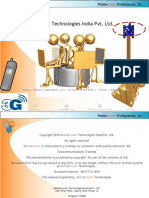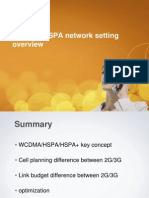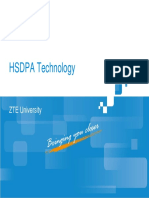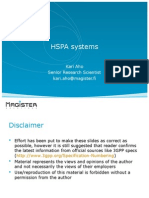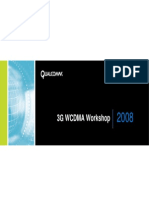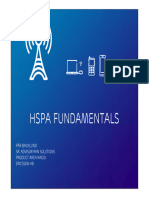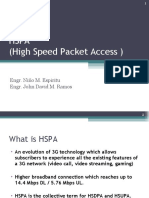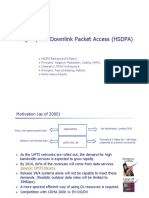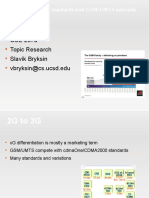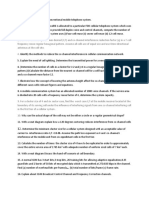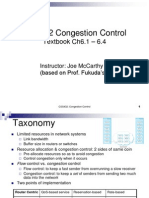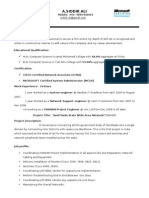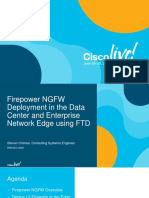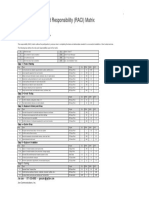HSPA BASIC
MobileComm Technologies India Pvt. Ltd.
Dallas
. Atlanta . Washington . LA .
Sao Paulo
. New Delhi .
Toronto
. Muscat. Sydney
�Copyright 2010 MobileComm Technologies India Pvt. Ltd. All rights reserved
MobileComm is committed to providing our customers with quality instructor led
Telecommunications Training. This documentation is protected by copyright. No part of the contents of this documentation may be reproduced in any form, or by any means, without the prior written consent of MobileComm Technologies . Document Number: RK/CT/3/2010 This manual prepared by: MobileComm Technologies
MobileComm Technologies(India)Pvt. Ltd. 424, First Floor, Udyog Vihar Phase -4, Gurgaon-122002 Headquarter: MobileComm Professionals Inc. 1255 West 15th Street, Suite 440 Plano, TX, 75075 Tel: (972) 633-5100 Fax: (972) 633-5106
www.mcpsinc.com
�HSPA Motivations
�3G Enables Wider Options of Services
�3G Enables Advanced Data Services
�HSPA for Higher Speed
What are the requirements for HSPA?
Data Rate Demand for higher peak data rates
Delay
Lower latency Capacity Better capacity and throughput
Better spectrum efficiency
Finer resource granularity Coverage Better coverage for higher data rate
�UMTS Data Rate Evolution
Uplink Peak Data Rate (Typical Downlink Peak Data Rate Deployment) (Typical Deployment) GSM GPRS EDGE WCDMA Release 99 HSDPA - Release 5 HSUPA - Release 6 9.6 kbps 20 kbps 60 kbps 64 kbps 384 kbps 1.4 Mbps (early deployment) 9.6 kbps 40 kbps 120 kbps 384 kbps 10 Mbps* 10 Mbps
�Applications Benefiting from HSPA
Voice-over-IP (VoIP)
Delay
Sensitive Error Tolerant
- Low latency, Quality of Service (QoS) control, fine resource granularity and improved capacity Video Telephony (in Packet Switched domain) - Low latency, Quality of Service (QoS) control, high data rates and improved coverage and capacity Gaming -Low latency, fast resource allocation
Delay
Tolerant Error Sensitive
Video Share / Picture Share - High Uplink data rates and improved coverage and capacity File Uploading (large files)
- High Uplink data rates and improved coverage and capacity
�UMTS Evolution / 3GPP Releases
matured GSM/GPRS CN
+ UTRAN
+ WCDMA Air Interface up to 384 kbps (2 Mbps)
Bearer independent CS CN CAMEL Phase 4 UTRA FDD repeater low chip rate TDD mode
HSDPA (14 Mbps) IMS Phase 1 W-AMR enhanced Location Services 1800/1900 MHz
HSUPA (5.76 Mbps) IMS Phase 2 WLAN-Interworking MBMS Push-services
Release 99 1999
Release 4
Release 99
Release 5
Release 4 Release 99
Release 6
Release 5 Release 4 Release 99
2001
2002/03
2005
Year
�HSPA Motivation and General Principle
Improved performance and spectral efficiency in DL and UL by introducing a shared channel principle: Significant enhancement with peak rates up to 14.4 Mbps in DL, and 2 Mbps in UL Huge capacity increase per site; no site pre-planning necessary Improved end user experience: reduced delay/latency, high response time
Rel. 99 Dedicated pipe for every UE HSUPA (3GPP Rel6) Dedicated pipe for every UE in UL Pipe (codes and grants) changing with time E-DCH scheduling HSDPA (3GPP Rel5) Fast pipe is shared among UEs
�HSDPA Basic
�What is High Speed Downlink Packet Access (HSDPA)
SPEED
CAPACITY
REDUCED DELAY
Higher bit rates: up to 14 Mbps
2 3 times improved system throughput
Reduced round trip time
STANDARDIZED
Smooth Upgrade
Integral part of WCDMA (3GPP Release 5) Short time to market with existing sites
�HSDPA
What is HSDPA? A UMTS packet air interface 3.6 Mbps up to theoretical 14.4 Mbps peak/user Add-on solution on top of 3GPP R99/R4 architecture HSDPA terminals co-exist with R99 terminals No modification to the Core Network & Traffic Classes Difference between HSDPA and WCDMA today? More Content for High End Users (5x faster and lower latency of 150 ms) More Data Users per Cell (because it is ~10x more spectrally efficient)
�Introduction HSDPA Basics
Adaptive Modulation and Coding (AMC) - Depending on UE channel conditions (CQI) - QPSK, 16QAM - Coding rate (1/4 - 3/4) - Data rate adapted on 2 ms time basis
Fast Retransmission - Hybrid Automatic Repeat reQuest (HARQ) - UE soft-combines data - Reduced RTT Fast Packet Scheduling (PS) Scheduling of users on 2 ms time basis New radio channels included for HSDPA - DL: HS-(P)DSCH, HS-SCCH - UL: HS-DPCCH It is important tonote that downlink HSDPA is a shared data channel - End user throughput depends on the number of the other users on the same HSDPA cell - Capacity planning and dimensioning of HSDPA is different to non-real time (NRT) DCH bearer
�HSDPA Basic Principles
Dynamic Power Allocation
Efficient power & spectrum utilisation
Shared Channel Transmission
Dynamically shared in time & code domain
Fast Hybrid ARQ with Soft Combining
Reduced round trip delay
Higher-order Modulation
16QAM in complement to QPSK for higher peak bit rates
Fast Link Adaptation
Data rate adapted to radio conditions on 2 ms time basis
2 ms
Fast Radio Channel Dependent Scheduling
Scheduling of users on 2 ms time basis
Short TTI (2 ms)
Reduced round trip delay
�Dynamic Power Allocation
3GPP Release 99
Power Power
3GPP Release 5
Total cell power
Total cell power
Unused power
Used for HSDPA
Dedicated channels (power controlled) Common channels t Power usage with dedicated channels
Dedicated channels (power controlled) Common channels
t
Power usage with dedicated channels
�Shared Channel Transmission
A set of radio resources dynamically shared among multiple users, primarily in the time domain.
SF=1
SF=2 SF=4 SF=8 SF=16
Channelization codes allocated for HS-DSCH transmission 5 codes (example)
TTI
Shared channelization codes
User #1
User #2
User #3
User #4
Up to 15 codes (SF16) can be allocated and shared between the users. It also depends on what the UE can support.
�Shared Channel Transmission
Multi Code Operation
SF = 1 2 4 8
C8,0 = [11111111] C4,0 = [1111]
SF = 16
C16,0 = [.........] C16,1 = [.........] C16,2 = [.........] C16,3 = [.........] C16,4 = [.........] C16,5 = [.........] C16,6 = [.........] C16,7= [.........] C16,8 = [.........] C16,9 = [.........] C16,10 = [........] C16,11 = [........] C16,12 = [........] C16,13 = [........] C16,14 = [........] C16,15 = [........]
...
256
512
C8,1 = [1111-1-1-1-1]
C2,0 = [11] C8,2 = [11-1-111-1-1] C4,1 = [11-1-1] C8,3 = [11-1-1-1-111] C1,0 = [1] C8,4 = [1-11-11-11-1] C4,2 = [1-11-1] C8,5 = [1-11-1-11-11] C2,1 = [1-1] C8,6 = [1-1-111-1-11] C4,3 = [1-1-11] C8,7 = [1-1-11-111-1]
�CQI Channel Quality Indicator
UE sends CQI info in the UL to aid rate adaptation and scheduling
CQI (1-30) provides the Node B with a measure of the UE's perceived channel quality and the UE receiver performance
The CQI report estimates the number of bits that can be transmitted to the UE using a certain assumed power with a block error rate of 10%
Modulation (QPSK, 16QAM) self-adaptive Good channel state: 16QAM
CQI (Report periodically)
Bad channel state: QPSK Coding rate (1/3, 3/4, etc.) self-adaptive Node B Good channel state: 3/4 Bad channel state: 1/3
�Fast Link Adaptation
Rate control Adjusts data rate based on the Radio conditions (CQI) Fast Adaptation : 2 ms TTI basis Adaptive Modulation (QPSK and 16 QAM) and Coding Use available power
Power
High data rate
Total cell power
HS-DSCH (rate controlled)
Dedicated channels (power controlled) Common channels HS-DSCH with dynamic power allocation t
Low data rate
�Fast Hybrid ARQ with Soft Combining
HARQ
For Fast retransmissions
�Fast Hybrid ARQ with Soft Combining
During retransmission, the UW employs soft combining.
1st Decoding in UE
2nd Decoding in UE
Final Picture
�Fast Channel-dependent Scheduling Fast Scheduling
Fast Scheduling in the Time domain (1): Transmission Time Interval (TTI) of 2ms assigned to users A short TTI reduces round-trip time and improves the tracking of channel variations the length of HSDPA sub-frame (TTI) is 3 slots (7680 chips)
Data Ndata1 bits Tslot = 2560 chips, M*10*2 k bits (k=4)
in the Node-B
Slot #0
Slot#1 1 HS-PDSCH subframe: T f = 2 ms
Slot #2
HSPA Basics
�Fast Channel-dependent Scheduling
Fast Scheduling
in the Node-B
Fast Scheduling in the Time domain (2): Transmission is based on: Channel Quality UE Capabilities Current load in the cell (available resources / buffer status) Traffic Priority classes / QoS classes UE Feedback (ACK/NACK) Fast Scheduling in the code Domain Up to 15 codes in parallel per TTI
HSPA Basics
�Queue Selection Algorithms
Round Robin RR: Assigns sub-frames in rotation
User at cell edge served as frequently as user at cell centre
Doesnt account for UEs channel conditions Low total throughput in cell
If no data have to be transferred to certain UE then sub-frame assigned to next UE
Proportional Fair PF:
Takes into account multipath fading conditions experienced by UE
Improved total throughput in cell compared to RR
Sub-frames assigned according scheduling metric
Ratio instantaneous data rate / average data rate experienced in the past User at cell edge served less frequently as user at cell centre
�Adaptive Modulation & Coding (AMC)
High Order modulation: 16QAM Code Multiplexing: up to 15 codes in parallel User can be code and time multiplexed (TTI= 2ms)
Codes
TTI = 2ms
Fixed Spreading Factor, SF=16
-> 3.84Mcps/16 = 240 K symbols/s
User 3
-> @ 16QAM -> 240 x 4 = 960 kbps -> @ code rate = 3/4 -> 720 kbps
User 2
User 1
720 kbps bit rate can be achieved per code -> 10.8 Mbps over 15 codes
Time and Code multiplexing in HSDPA
HSPA Basics
�Adaptive Modulation & Coding (AMC) 16 QAM allows twice the data rate to a user compared to QPSK Currently all R99 channels use QPSK 16 QAM will only be possible for users within a limited radius of the NodeB (<20 % of the cell area ?) The Adaptive Modulation Coding scheme : can be controlled (changed) every 2 ms TTI to account for changing radio conditions can be different for different users in different radio conditions
SF = 16 240 ksymb/s Multi-Code operation: 1..15 codes 0.24 .. 3.6 Msymb/s
�Adaptive Modulation & Coding (AMC)
t
5
Number of allocated codes
UE 1
UE 3 UE 2
UE 1 UE 3 UE 2
UE 1
UE 3
UE 1 UE 3 UE 2 Time etc
QPSK TTI 0 2ms
16 QAM TTI 1
QPSK TTI 2
16 QAM 16 QAM TTI 3 TTI 4
QPSK TTI 5
user in a changing user in a good radio channel radio channel
user in a poor radio channel
�Adaptive Modulation & Coding (AMC) Coding is used to protect the user data bits from errors HSDPA has a very flexible coding scheme which can vary every 2ms and between each user This allows a much more varied distribution of data rates within a cell Higher rates in very good radio conditions near the NodeB Higher rates compared to R99 on cell edge
�UE Support for AMC
Maximum data rate possible to a single user depends heavily on the UE they are using There are 12 categories defined in the standards for different levels of HSDPA support
Category
1 2 3 4 5 6 7 8 9 10 11 12
Codes
5 5 5 5 5 5 10 10 15 15 5 5
Inter-TTI
3 3 2 2 1 1 1 1 1 1 2 1
Modulation
QPSK/16QAM QPSK/16QAM QPSK/16QAM QPSK/16QAM QPSK/16QAM QPSK/16QAM QPSK/16QAM QPSK/16QAM QPSK/16QAM QPSK/16QAM QPSK only QPSK only
Data rate
1.2 Mbps 1.2 Mbps 1.8 Mbps 1.8 Mbps 3.6 Mbps 3.6 Mbps 7.2 Mbps 7.2 Mbps 10.2 Mbps 14.4 Mbps 0.9 Mbps 1.8 Mbps
�The big picture for HSDPA
Node B
Backhaul RNC Core Network HLR
Increased processing power (HW) RF power allocation to HSDPA (min,max) Management of new device categories & signalling ch. Software upgrade
Additional Additional
backhaul capacity bandwidth to support Software upgrade higher data rates
Additional
capacity
Extended QoS
field for HSDPA devices (for data rates >8 Mbps)
�Summary of HSDPA key benefits
Adapted to bursty traffic (statistical Adapted to variablethroughput flows Multiplexing benefit)
Throughputs of : Up to 3.6 Mbps with QPSK Up to 14 Mbps with
16QAM
High Speed
Downlink Packet
Access
Cost effective Quicker response time Mix of HSDPA and dedicated traffic possible on same carrier
HSPA Basics
�HSDPA Limitations
HSDPA does not respond for the following needs High uplink speed (uploading, video calls, video conferences, browsing, online gaming, E-commerce) Large capacity (Limited number of users) Limited coverage (WCDMA has lower coverage than GSM in rural areas WCDMA infrastructure is not profitable)
POSSIBLE SOLUTIONS: 1. HSUPA significantly improved uplink 2. WiMAX significantly improved capacity 3. CDMA2000 increased coverage
Fabricio Martinez
�HSDPA Channels
�Physical Channel Overview
High-Speed Physical DL Shared Channel
HS-PDSCH
HS-SCCH
High Speed Shared Control Channel
High Speed Dedicated Physical Control Channel
HS-DPCCH
Node B MAC-hs
Dedicated Channel (Rel. 99)
associated DCH
F-DPCH
Fractional Dedicated Physical Channel (Rel. 6/7)
�HS-PDSCH
HS-PDSCH: High-Speed Physical Downlink Shared Channel Transfer of actual HSDPA data 5 - 15 code channels QPSK or 16QAM modulation 2 ms TTIs Fixed SF16
SF= 1 SF= 2 SF= 4 SF= 8
SF=16
allocated for other channels
Example: Allocated for HS-DSCH
�HS-SCCH
HS-SCCH: High-Speed Shared Control Channel
L1 Control Data for UE; informs the UE how to decode the next HS-PDSCH frame e.g. UE Identity, Channelisation Code Set, Modulation Scheme, TBS, H-ARQ process information Fixed SF128 transmitted 2 slots in advance to HS-PDSCHs NSN implementation with slow power control: shares DL power with the HS-PDSCH more than 1 HS-SCCH required when Code Multiplexing is used Up to 4 HS-SCCHs Codes
SF16 HS-PDSCH
15
User 1
User 2
User 3
User 4
Subframe 2 ms
10
Time
TBS: Transport Block Size
�HS-DPCCH
UL HS-DPCCH: High-Speed Dedicated Physical Control Channel
MAC-hs Ack/Nack information (send when data received) Channel Quality Information (CQI reports send every 4ms, hardcoded period) Fixed SF 256 1 Slot = 2560 chip 2 Slots = 5120 chip CQI (20 bit) Channel Quality Indication
HARQ-ACK (10 bit)
1 HS-DPCCH Subframe = 2ms
Subframe # 0
Subframe # i
Subframe # N
CQI values = 0 (N/A), 1 .. 30; steps: 1; 1 indicating lowest, 30 highest air interface quality
�HS-DPCCH & CQI
CQI P-CPICH
1 2 3 4 5 6 7 8 9 10 11 12 13
TB Size
137 173 233 317 377 461 650 792 931 1262 1483 1742 2279 2583 3319 3565 4189 4664 5287 5887 6554 7168 9719 11418 14411 14411 14411 14411 14411 14411
# codes Modulation
1 1 1 1 1 1 2 2 2 3 3 3 4 4 5 5 5 5 5 5 5 5 7 8 10 12 12 12 12 12 QPSK QPSK QPSK QPSK QPSK QPSK QPSK QPSK QPSK QPSK QPSK QPSK QPSK QPSK QPSK 16-QAM 16-QAM 16-QAM 16-QAM 16-QAM 16-QAM 16-QAM 16-QAM 16-QAM 16-QAM 16-QAM 16-QAM 16-QAM 16-QAM 16-QAM 0 0 0 0 0 0 0 0 0 0 0 0 0 0 0 0 0 0 0 0 0 0 0 0 0 -1 -2 -3 -4 -5
UE observes P-CPICH (Ec/Io) CQI*
CQI used for:
Link Adaptation decision Packet Scheduling decision
14 15 16 17 18
ACK/NACK used for:
H-ARQ process
Link Adaptation decision HS-SCCH power adaptation
19 20 21 22 23 24 25
* UE internal (proprietary) process TB Size [bit] CQI value 0: N/A (Out of range) = Reference Power Adjustment (Power Offset) [dB]
26 27 28 29 30
�Associated DCH (DL & UL)
DL DPCH: Associated Dedicated Physical Channel
Transfer of L3 signalling messages Speech - AMR Power control commands for associated UL DPCH
UL DPCH: (DPDCH & DPCCH)
Transfer of L3 signalling messages Transfer of UL data 16 / 64 / 128 / 384 kbps, e.g. TCP acknowledgements Speech - AMR
DPDCH / DPCCH (time multiplexed)
DPDCH: L3 signalling; AMR DPCCH: TPC for UL DPCH power control
DPDCH: L3 signalling, AMR; TCP ACKs;
16 / 64 / 128 348 kbps
DPCCH: TPC, Pilot, TFCI
�Fractional DPCH: F-DPCH (DL)
The Fractional DPCH (F-DPCH): was introduced in 3GPP Rel. 6 replaces the DL DPCCH when the DL DPDCH is not present, i.e. both application data and SRB are transferred using HSDPA includes Transmit Power Control (TPC) bits but excludes TFCI & Pilot bits TFCI bits - no longer required as there is no DPDCH Pilot bits - no longer required as TPC bits are used for SIR measurements increases efficiency by allowing up to 10 UE to share the same DL SF256 channelisation code - time multiplexed one after another
1 time slot 2560 chips 256 chips Tx Off
TPC
Tx Off
Slot #i
�HSUPA Basics
�HSUPA Introduction
HSUPA: High Speed Uplink Packet Access
3GPP release 6 feature Also called Enhanced DCH or Enhanced Uplink Purposes: Boost uplink data performances in terms of higher throughput, reduced delay and higher capacity Balance uplink traffic performance with downlink HSDPA Mandatory step for VoIP
43 | HSPA Basics
�HSUPA Overview
1-4 Code Multi-Code transmission
TTI = 10 ms
Hybrid ARQ with incr. redundancy
Fast Power Control
NodeB ControlledS cheduling
Benefit Higher Uplink Peak rates: 2.0 Mbps Higher Capacity: +50-100% Reduced Latency: ~50-75 ms
�HSUPA Key Features
Scheduling at Node-B
Shorter TTI
10 or 2ms
HSUPA HARQ
for fast
retransmissions
45 | HSPA Basics
�HSUPA Key Feature: H-ARQ
H-ARQ
For Fast retransmissions
RLC ACK/NACK
Hybrid-Automatic Repeat Request Retransmission with chase combining or incremental redundancy Packet Terminated in Node-B Smaller delay Higher BLER target -> smaller Transmit Power and interference -> Higher capacity
46 | HSPA Basics
Packet
L1 ACK/NACK
Retransmission Retransmission
R99 DCH
R6 E-DCH
�HSUPA Key Feature Scheduling (1)
Scheduling
in the Node-B
L3 Resource Allocation
Scheduling in the Node-B Not anymore handled by the RNC Whenever the UE stops the transmission or reduces the data rate, the free capacity can be quickly allocated to another UE Algorithm is vendor dependent
Data transmission
Scheduling Info
Scheduling Assignment
R6 E-DCH
47 | HSPA Basics
�HSUPA Key Feature Scheduling (2)
Scheduling
in the Node-B RoT Maximum allowable noise rise
UE 1 UE 2
UE 3 UE 2 UE 1
UE 3 UE 2
Shared resource is the total Uplink interference eg Rise over Thermal Noise, RoT or interference margin The Node B controls the allocation of this margin Selects the best Transport Format Combination (TFC) for a given UE according to the available interference margin (left over R99) and schedules the UE
48 | HSPA Basics
UE 1
UE 1
TTI 0
TTI 1
TTI 2
TTI 3 Time
DCH services
(eg voice and video)
�HSUPA Channels
�Physical Channel Overview
Scheduling information (MAC-e on E-DPDCH) or happy bit (E-DPCCH)
Scheduling Request
E-DCH Absolute Grant Channel E-RNTI & max. power ratio E-DPDCH/DPCCH (Absolute Grant)
E-AGCH
Scheduling Grants
E-DCH Relative Grant Channel UP / HOLD / DOWN (Relative Grant)
E-RGCH
E-DCH Dedicated Physical Control Channel L1 control: E-TFCI, RSN, happy bit
E-DPCCH
UE
Node B
E-DCH Dedicated Physical Data Channel User data & CRC E-HICH
E-DCH Hybrid ARQ Indicator Channel ACK/NACK
RSN: Re-transmission sequence number
E-DPDCH
�New Physical Channels
HSUPA : New physical channels: Uplink: E-DPDCH: E-DCH Dedicated Physical Data Channel E-DPCCH: E-DCH Dedicated Physical Control Channel Downlink E-AGCH:E-DCH Absolute Grant Channel E-RGCH:E-DCH Relative Grant Channel E-HICH:E-DCH HARQ Acknowledgement Indicator Channel
51 | HSPA Basics
�New Physical Channels
E-DPDCH SF 2 to 256, Uplink, Dedicated channel Multicode possible: 2xSF4, 2xSF2, 2xSF2+2xSF4 Information sent on this channel: Data E-DPCCH SF 256, Uplink, Dedicated channel Information sent on this channel: E-TFCI: E-DCH Transport Format Combination Indicator (ie indicates the transport block size used on E-DPDCH) RSN: Retransmission Sequence Number (informs about the HARQ sequence number of the transport block sent on E-DPDCH ie 0 if first transmission, 1,2or 3 if retransmission) Happy bit: indicates if the UE is happy with current data rate or if a higher power can be used.
52 | HSPA Basics
�HSUPA UE Categories
Mac-e data rates
Theoretical peak bit rate up to 5.76 Mbps 1.46 Mbps capability expected initially
53 | HSPA Basics
�Summary of HSUPA benefits
Deployed as an overlay of R99 and R5 networks
Better usage of the resources (interference)
UE Throughputs up to 5.8Mbps
Up to 1.4Mbps in a first step
30-70% increase in system capacity 50% increase in user packet call throughput UL coverage improvement for high data bit rate
High Speed Uplink Packet Access
20-55% reduction in enduser packet call delay
New services
VoIP, Mobile Gaming, Video Conferencing
New revenues for operators & better QoS for users
54 | HSPA Basics
�HSPA mobility
HSDPA Soft handover on associated DCH channels (signalling, UL data) Serving cell change for HSDPA data channel
Connected only to one cell at a time Notice that soft/softer handover is not supported for HS-SCCH/HS-PDSCH
HS-SCCH
Serving HS-DSCH cell
HS-PDSCH
DPCH
DPCH
HSUPA Soft handover utilised for uplink channels as required due to near-far problem Only Serving Cell can allocate more UL capacity/power
�Physical Channel Overview R99/R5/R6
Node B
256)
128)
UE
�HSPA UE Evolution
Rel5 HSDPA for downlink
714 Mbit/s Category 710
Rel6 HSUPA for uplink
HSDPA handsets 2nd generation
5 Mbit/s
Category 5, 6 3.6 Mbit/s
HSDPA handsets 1st generation
HSUPA handsets & PC cards 2nd generation
TTI=2 ms
Category 11, 12 0.9, 1.8 Mbit/s
HSDPA PC cards PS only
HSUPA handsets & PC cards 1st generation
1-2 Mbit/s TTI=10 ms
2005
57 | HSPA Basics
2006
2007
2008
�Comparison with R99 DCH and R5 HSDPA
Cha nnel Channel Type Spreading Factor L1- H-ARQ Multicode transmission TTI length (ms) Adaptive Modulation Node B Scheduling Fast Power Control Soft Handover
DCH (R99) Dedicated Variable No Possible 40 / 20 / 10 No No Yes Yes
HSDPA (R5) Shared Fixed (SF = 16) Yes Yes 2 Yes Yes No No
HSUPA E- DCH (R6) Dedica ted Va ria ble Yes Yes 10 / 2 No Yes Yes Yes
58 | HSPA Basics
�www.mcpsinc.com
